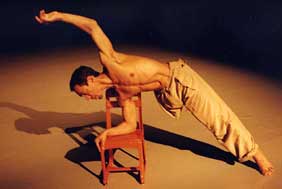
I was fortunate to see Homer Avila dance twice, as a guest with AXIS Dance Company, before he died from cancer in April. He threw himself back into dancing after the amputation of one of his legs, and there was nothing the slightest bit pitiful about his performances. I attended his memorial here in San Francisco last month and wrote the following:
On a Sunday morning in June, three dozen dancers and choreographers ventured to San Francisco?s former Odd Fellows Hall, located on one of downtown?s most derelict street corners, and rode the cranky, fusty smelling elevator to the sixth floor. There they entered an abandoned clan meeting room, replete with thrones and cultish symbols, perhaps paused to light a candle, and took a seat among the rows of metal folding chairs in the center.
They came to remember a colleague who had become a hero. The compact, gymnastic Homer Avila had already achieved success as a dancer with the companies of Twyla Tharp and Bill T. Jones when, in 2001, he felt a sharper than usual pain in his hip and learned that he had cancer. Like most dancers, he had no health insurance and no family money to call upon. His leg and part of his hip was removed three weeks after his diagnosis. Less than four months later he came to the San Francisco Dance Center, which now occupies the Odd Fellows building, to learn to dance again.
?I felt he was imagining his whole body moving,? said Barbara Paige Kaplan, the former publisher of Dance Magazine, about watching Avila take class. ?Every turn, every extension was complete in his mind, and you could see all of it in his upper body.?
Kaplan was so astonished by his comeback that she put him on the cover of the magazine and became a friend. At Sunday?s gathering, which she organized, Kaplan played a clip from ?Solo,? created for Avila by Los Angeles choreographer Victoria Marks in 2002. On the screen, Avila stood on his single leg and stared at the audience, hand to heart. He pumped his arms in slow motion as if to run. And then like a shot he was lying on his side, furiously pedaling himself across the stage with one leg.
After the clip Marks, who met Avila in 1978, spoke of pushing Homer to open himself to the audience, and his response, ?I?m not feeling generous today.? ?I was angry with Homer a lot for what he didn?t do and how he wasn?t there,? Marks tearfully admitted. ?Now I realize how hard he was struggling to be there for himself and for us. He gave himself to his art despite his body?s protestations. His success became an antidote to his pain and to ours.?
Known to kick a door open, Avila never asked to be treated as a charity case. He came to the SF Dance Center?s summer intensive to work with choreographer Alonzo King and discover, as Avila tells it in a forthcoming documentary film, ?what was left.? Within weeks he could not only stand securely on his single leg, but bound across the floor with a kind of defiant grace. As the dance writer Paul Parish once said, ?He made you see the missing leg.? He moved so beautifully that King made one of his most emotional duets, ?Pas,? for him.
Avila?s determination allowed him to reach a wider audience than he had known as co-director, with the statuesque Adisa Weeks, of Avila/Weeks Dance. He performed ?Pas? at the Kennedy Center. He flew to Germany to have a solo made for him by Dana Caspersen, wife of Ballett Frankfurt?s William Forsythe. He brought new believers to the field of ?physically integrated dance,? which combines performers with and without disabilities, by appearing with Oakland?s AXIS Dance Company. ?He was a professional dancer, and a very good dancer,? AXIS director Judith Smith during the memorial?s open microphone. ?But he wasn?t afraid to embrace the disabled community.?
The disabled community and the dance community embraced Avila, who danced until two days before his death, on April 25. ?I didn?t think I would do this,? Kaplan said after the films of his dancing had been shown and the crowd had been asked to share their remembrances. She stood and assumed the open-armed stance from one of Homer?s solos and repeated the lines he had once delivered with such steely dignity in his sharp brown eyes. ?Homer David Avila. Homer David Avila. Homer David Avila.? For a moment you could feel his presence, a solid ?Y? with one leg firmly rooted, two arms reaching to fly.

1 Comment
nice
Add Comment